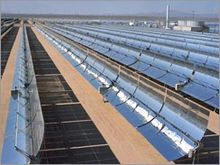| |
Solar Thermal Energy Systems Design |
| |
Solar thermal systems utilize
radiation from the sun to produce heat. This heat can be used to
produce steam for process applications or to drive a turbine and
produce electricity. Solar thermal electricity represents a huge
domestic energy resource, and there is a
growing interest in using this resource because of the reduced CO2
emissions. We specialize in designing
- Small-Scale Solar Electric
Power Plants
- Systems for producing Process
Steam
- High-efficiency flat plate
solar thermal collectors
We provide (a) project engineering
feasibility studies, (b) equipment procurement and (c) system
construction and commissioning. |
| |
Small-Scale Solar Electric Power
Plants |
| |
|
Solar electric power using parabolic troughs
collectors are one of the
lowest cost solar electric power options available today. Current
cost of electricity from parabolic trough power plants is
$0.10 to $0.12 per kWh. The expectation is to reduce this
cost to $0.04 to $0.05 per kWh. |
 |
|
Parabolic
trough power plants use curved, mirrored trough which
reflects the direct solar radiation onto a receiver pipe
running the length of the trough. They can focus the sun at 30-60 times its normal
intensity on the receiver pipe. A heat
transfer fluid, usually oil, flows through the pipe. This
fluid is then used to generate steam for industrial
processes or to power a steam turbine
coupled to an electric generator. |
|
The collectors trough is rotated to follow
the sun to maximize the suns energy input to the receiver
tube. The trough does not require tracking on a second axis. |
|
| |
Thermal Energy
Storage Module |
| |
The thermal electric solar plants can
provide continuous power (day or night) through the integration of
thermal energy storage. In our design, a thermal energy
storage module is developed to allows solar thermal energy
(collected during the day) to be used to generate solar electricity
to meet demand during the evenings and summer peak hours. |
| |
|
| |
The thermal storage system uses a two
tank system in which some of the heat from the Parabolic Trough
system is stored in a "Hot Tank". Some of the Heat Transfer Fluid is
routed through a heat exchanger as fluid (typically a nitrate salt
solution) from a "Cold Tank" is pumped into the "Hot Tank", thus
transferring heat from the solar field to the "Hot Tank". At night
(or during periods of high demand) the hot salt solution us used to
heat the Heat Transfer Fluid
flows, by pumping it to the "Cold Tank" through the heat exchanger. |
| |
|
| |
Make Inquiry |